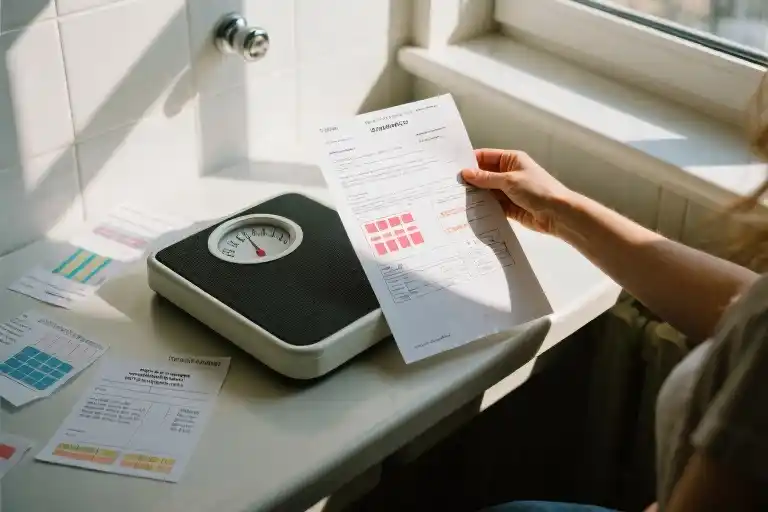The framed photos on my sister’s living room wall tell a story more complex than any before-and-after weight loss transformation. On the left, her radiant smile at a beach party – arms confidently wrapped around friends, sundress hugging curves that society would label ‘plus-size’. On the right, the same luminous smile at her graduation – 100 pounds lighter, but with shadows under her eyes that no diet could erase. Between these bookends of her journey hangs a handwritten note: “Stop telling me I’m beautiful; it has nothing to do with why I want to lose weight.”
Our family tree reads like a medical textbook case study – three generations, five confirmed diabetes diagnoses, and two sleep apnea machines humming through childhood nights. When my sister’s prediabetes test came back positive last year, it wasn’t vanity that made her overhaul her eating habits; it was the memory of our uncle losing his foot to neuropathy. Yet whenever she orders grilled salmon instead of pasta at business lunches, well-meaning colleagues stage interventions disguised as compliments: “You’re perfect as you are!” as if preventing diabetes somehow equates to rejecting self-love.
The irony stings harder when I recall my own journey. At my heaviest – when blood pressure meds joined my morning routine – I ironically experienced what sociologists call the “dadbod dividend.” Dating apps buzzed with matches praising my “bear-like charm,” while friends envied my ability to “own my size.” This cultural fetishization of certain body types created dangerous rationalizations: If being attractive means being unhealthy, maybe health isn’t the priority? It took a sleep study showing 42 apnea events per hour – moments when my breathing simply stopped – to shatter that warped logic.
What both our stories reveal is society’s stubborn conflation of health-focused weight loss with appearance anxiety. The same culture that shames people for their size paradoxically resists when they attempt change for non-cosmetic reasons. My sister’s salad becomes a Rorschach test – coworkers project their own body image issues onto her lettuce leaves, just as my refusal of office donuts sparks concerned whispers about “disordered eating.” Behind every “You don’t need to diet!” lurks the unspoken assumption that weight management must stem from insecurity rather than, say, preventing the amputations that run in our family.
Medical reality rarely aligns with these social narratives. My sister’s sleep apnea improved before the scale registered significant change – her first non-scale victory came when she stopped gasping awake at 3 AM. My own prediabetes reversal involved zero waistline measurements but required meticulous glucose monitoring. Yet we’ve internalized such twisted metrics that even doctors often lead with “Let’s get you down to a healthy weight” rather than “Let’s stabilize your A1C.”
Perhaps the most pernicious myth is that body confidence precludes health optimization. My sister laughs recalling how teenage boys’ cruel nicknames never dimmed her self-assurance – it was lab results, not mirrors, that prompted change. My food journals reveal the same paradox: childhood shame around secret PB&J binges gave way to adult clarity about nutrition’s role in managing genetic risks. We’re living proof that you can simultaneously believe “I’m enough as I am” and “I deserve better biomarkers.”
This cultural confusion manifests differently across genders. As a man, I’m expected to be the human garbage disposal – coworkers nudge extra slices toward me like it’s my civic duty. When I decline, reactions range from bafflement (“Big guy like you?”) to concern (*”You’re not one of those clean-eating weirdos, are you?”). My sister navigates the opposite extreme: her shrinking dress size suddenly made her visible to men who’d literally stepped around her in crowded bars. Their newfound attention feels less like romance than proof of society’s shallow metrics.
Beneath these interactions runs a toxic undercurrent – the presumption that we’re all chasing the same narrow beauty standard. When my sister snaps “I know I’m beautiful!” at salad-praising friends, she’s rejecting not their kindness but their unspoken premise: that no one would choose vegetables unless trying to conform. My exasperated “I’m trying not to die in my sleep!” startles food-pushers because it reveals their projection – they assume my lunch choices reflect vanity rather than the very practical desire to meet my future grandchildren.
The photos on my sister’s wall ultimately capture this duality – not a transformation from “ugly” to “beautiful,” but from one type of health struggle to another. The real evolution happened off-camera: learning to say “No” without apology, deciphering genuine support from performative reassurance, and most crucially, divorcing medical necessity from society’s beauty scripts. Our family’s diabetes risk won’t disappear, but perhaps we can help rewrite the cultural narrative – one glucose meter reading, one uncommented-on salad, one honest conversation at a time.
When ‘Kindness’ Becomes Pressure
The Office Pizza Paradox
It’s 11:47 AM on Wednesday when the email blast hits your inbox: “Pizza party in the breakroom!” Within minutes, colleagues materialize around the steaming boxes like seagulls at a beach picnic. You quietly retrieve your prepped salad from the office fridge – that crisp $14 investment in your future pancreas function.
Then comes the look. Not from Karen from accounting (she’s too busy calculating cheese-to-crust ratios), but from well-meaning Dave. His eyebrows perform that sympathetic little dance as he gestures toward the pepperoni feast. “Come on, live a little! You’re beautiful just as you are.”
This is what my sister calls salad sympathy – that peculiar blend of pity and projection disguised as support. When she lost 100 pounds to reverse her prediabetes diagnosis, these interactions became her daily minefield. “People act like ordering grilled chicken instead of fried is some tragic act of self-denial,” she told me during our weekly vent session. “I’m not punishing myself – I’m preventing my feet from going numb!”
The Garbage Disposal Dilemma (A Male Perspective)
As the resident “big guy” in my friend group, I’ve been typecast in society’s unspoken food theater:
- The Human Compactor: “Jimmy’ll finish it!” (Said while sliding half-eaten nachos my direction)
- The Temptation Sidekick: “If you get the molten lava cake, I will too!” (Said by someone who runs marathons for fun)
- The Concern Projection: “You’re not dieting, are you?” (Said with the horror usually reserved for vegan converts)
A 2021 International Journal of Obesity study found 68% of overweight individuals report experiencing “food pushing” from colleagues and family. What fascinates me isn’t the behavior itself, but its emotional blueprint:
- Stage 1: Food offer (“Try my homemade baklava!”)
- Stage 2: Rejection discomfort (“Oh come on, one bite won’t kill you”)
- Stage 3: Moral intervention (“Life’s too short to count calories”)
The Hidden Curriculum of Eating
These interactions reveal our cultural script about weight and worth:
- Assumption 1: Dietary choices = body image struggles
- Assumption 2: Health optimization = vanity project
- Assumption 3: Food refusal = personal rejection
My sister’s breakthrough came when she created her Boundary Menu – response options calibrated to the offender’s persistence level:
| Situation | Polite | Firm | Nuclear |
|---|---|---|---|
| Office treats | “Thanks, I’m good!” | “I don’t eat sugar at work” | “My endocrinologist says no” |
| Family dinners | “Saving room for later” | “I’ve had enough” | “Would you ask this if I had cancer?” |
What shocked us both? The nuclear option almost never gets used. Most people retreat at “firm” – not because they’re cruel, but because they genuinely don’t realize they’ve crossed from kindness into coercion.
The Metabolic Truth No One Discusses
Here’s what that pizza party doesn’t account for:
- Genetic Roulette: With our family’s diabetes history, my sister’s A1C levels were climbing faster than a toddler on sugar
- Silent Symptoms: Her sleep apnea wasn’t just snoring – it was her brain getting starved of oxygen 57 times per hour
- Invisible Damage: Every blood sugar spike was sandblasting her capillaries (as her ophthalmologist kept reminding her)
Yet in that breakroom moment, all anyone saw was a “woman denying herself pleasure” – reinforcing society’s stubborn equation: Thin = Happy / Healthy = Attractive. My sister’s actual equation looked more like: Stable Glucose = No Nerve Damage / CPAP Machine = Not Dying in Her Sleep.
Rewriting the Script
Three mindset shifts that helped us:
- Separate Intent from Impact: Recognize most comments come from good (if misguided) places
- Shortcut the Shame Spiral: “I appreciate your concern, but my doctor and I have a plan”
- Flip the Focus: Redirect conversations from bodies to actual health metrics
That last one transformed family gatherings. When Aunt Linda starts waxing poetic about my “glow up,” I now say: “My sleep study results were way more exciting – want to see my oxygen saturation graphs?” The conversation either becomes medically fascinating or dies immediately. Win-win.
Because ultimately, health-focused weight loss isn’t about shrinking bodies – it’s about expanding lives. And no amount of free pizza is worth compromising that.
When Health Gets Mistaken for Vanity
The Dating Paradox: When More Attraction Meant Less Health
During my heaviest years, something peculiar happened—my dating life peaked. At 280 pounds, I was fielding more romantic attention than during my leaner college years. Women would compliment my “cuddly bear” physique, friends envied my confidence, and bars became playgrounds where my size seemed to signal approachability rather than repel it.
This created a dangerous cognitive dissonance: If society finds me attractive like this, why change? For years, I weaponized this paradox against my doctor’s warnings. Then came the sleep apnea diagnosis.
Medical Metrics That Actually Matter
| Social Obsession | Health Reality |
|---|---|
| Jeans size | Liver enzyme levels |
| Scale numbers | Blood oxygen saturation |
| “Do I look fat?” | “Can I climb stairs without gasping?” |
The night my partner recorded me stopping breathing 27 times per hour, attractiveness rankings suddenly felt trivial. My sister’s pre-diabetes warning—the same condition that claimed our uncle’s toes—finally clicked. We weren’t rejecting our bodies; we were reclaiming them from cultural narratives that prioritize aesthetics over organ function.
The Life-Threatening Compliment
“You carry it so well!” people would tell me, mistaking my high pain tolerance for actual wellness. What they didn’t see:
- Waking up with headaches from oxygen deprivation
- Avoiding theme parks due to seatbelt extender shame
- Normalizing knee pain at 32 as “just part of being big”
When body positivity becomes blanket permission to ignore biomarkers—when “love yourself” drowns out “listen to your lab results”—it crosses from empowerment into endangerment. My sister put it best: “I didn’t stop loving my body when I lost weight—I started respecting what it needed.”
The Visibility Shift
After dropping 80 pounds, I noticed something unsettling: fewer flirtatious comments, more “concerned” questions about whether I was “still healthy.” Meanwhile, my sister experienced the opposite—her weight loss suddenly made her “visible” to men who’d ignored her before. This societal whiplash reveals the absurdity of linking health with attractiveness: we’re either shamed for our size or shamed for changing it.
Recalibrating Our Compass
Health-focused weight loss requires divorcing medical necessity from appearance anxiety. Three mindset shifts that helped me:
- Separate bloodwork from beauty – My A1C levels don’t care if I’m someone’s “type”
- Embrace non-scale victories – Walking without back pain > fitting into smaller jeans
- Detach from diet culture – Salad isn’t “virtuous”—it’s just one tool among many
That dating paradox? It wasn’t wrong—just irrelevant. Surviving middle age matters more than thriving on dating apps. As my sleep specialist said while adjusting my CPAP machine: “Romance is nice. Breathing is better.”
How to Set Healthy Food Boundaries Without Being Rude
Let’s get real for a moment—saying “no” to food in social situations can feel like navigating a culinary minefield. Whether it’s your aunt’s famous lasagna at family gatherings or the weekly office donut ritual, food pushers come armed with weapons of mass consumption: guilt trips, peer pressure, and those puppy-dog eyes when you decline seconds.
The 3-Level Food Rejection Playbook
Level 1: The Polite Deflection (For Casual Situations)
- “That looks amazing, but I’m saving room for dinner later!”
- “I’m still working through my first plate—maybe later!”
- Pro tip: Smile while saying this. People respond better to positive nonverbal cues even when hearing “no.”
Level 2: The Firm Boundary (For Persistent Pushers)
- “I appreciate you offering, but I’ve decided not to eat [specific food] right now.”
- “This is what works for my body—thanks for respecting that.”
- Key move: Use “I” statements to make it about your choice rather than their food.
Level 3: The Mic Drop (For Boundary Violators)
- “I’ve said no three times now. Let’s talk about something else.”
- “My eating habits aren’t up for discussion—how about those [insert sports team]?”
- Nuclear option: “Would you pressure an alcoholic to drink? This is the same principle.”
Non-Food Socializing Alternatives
When food-centric gatherings trigger your boundaries:
- Coffee walks (movement + caffeine = win/win)
- Museum/gallery outings (nobody eats near priceless art)
- Board game nights (hands stay busy rolling dice)
- Volunteer activities (food rarely central to habitat restoration)
flowchart TD
A[Someone Offers Food] --> B{Motivation Check}
B -->|Social Habit| C[Level 1 Response]
B -->|Validation Seeking| D[Level 2 Response]
B -->|Control Issues| E[Level 3 Response]
C --> F[Change Subject]
D --> G[Repeat Boundary]
E --> H[Disengage]Reading the Room: Why People Push Food
- Cultural Scripts: “Hosts must feed guests” mentality (especially strong in immigrant families)
- Personal Insecurity: Your refusal triggers their own diet guilt (“If they’re not eating, does that mean I shouldn’t either?”)
- Affection Expression: For some generations, food = love (see: every Italian grandmother ever)
- Social Lubrication: Shared eating creates false intimacy (“We’re bonding over carbs!”)
Remember: Your “no” isn’t about them. As my sister puts it: “My salad isn’t a commentary on your pizza—it’s just my lunch.” The more confidently you hold your boundaries, the quicker others adapt. And if they don’t? That information helps you decide who truly deserves a place at your table—metaphorically speaking.
Why We Cook Love Into Food
That half-eaten PB&J sandwich left on the kitchen counter at 2 AM wasn’t just a midnight snack—it was a love letter written in grape jelly and separation anxiety. In immigrant families like mine, food became the unspoken language of affection when words failed. McDonald’s Happy Meals weren’t just fast food; they were my working-class mother’s edible apologies for missed school plays, packaged with a side of guilt and extra fries.
The Fast Food Love Language
Our family album could’ve been a McDonald’s menu board: birthday parties under golden arches, good report cards celebrated with Chicken McNuggets, bad breakups soothed by McFlurries. This wasn’t neglect—it was love translated through drive-thru windows when my exhausted parents had nothing left to give. The scent of fries still triggers visceral memories of my mother’s tired smile as she unwrapped my cheeseburger, her fingers smelling of hospital disinfectant from her nursing shift.
Yet this edible love came with hidden costs. My father, having watched diabetes claim his father’s legs, developed what I now recognize as fatphobic panic. His disapproving glances at my second helping of mac and cheese taught me to associate nourishment with shame. “Why do you eat so much?” he’d ask, not realizing the answer was etched in our family’s DNA and circumstance—we weren’t just consuming calories, we were swallowing generations of unprocessed trauma.
The Nighttime Sandwich Ritual
By age twelve, I’d mastered the art of stealth eating—triple-decker sandwiches constructed in moonlit kitchens, hastily chewed bites muffled against my pillow. These weren’t acts of gluttony but survival mechanisms, my childish attempt to self-soothe in a home where emotions were served frozen and reheated. The crunch of peanut butter crackers at midnight became my lullaby, the rustle of chip bags my comfort white noise.
Looking back through my food-stained timeline reveals painful contrasts:
| Childhood Eating | Adult Eating |
|---|---|
| Secretive midnight binges | Publicly declining dessert without apology |
| Hiding wrappers like drug paraphernalia | Meal prepping with theatrical flourish |
| Flinching at “big guy” comments | Owning my body’s needs unapologetically |
Breaking the Cycle
The turning point came when I realized our family’s culinary love language needed translation. My mother’s fried chicken wasn’t just clogging my arteries—it was her way of saying “I survived today so you could thrive tomorrow.” My father’s critiques weren’t about my waistline but his terror of repeating family medical history. This awareness allowed me to reframe our relationship with food:
- Separate nourishment from emotion – Learned to sit with discomfort instead of chewing it
- Rewrite food rituals – Replaced late-night binges with morning meal prep meditation
- Establish generational boundaries – Politely decline seconds while affirming the love behind the offer
The Bittersweet Taste of Progress
Now when I visit my parents, our interactions have shifted from food-centric to experience-focused. Instead of gathering around heaping plates, we take walks while discussing family health history—not with shame but with pragmatic concern. That childhood kitchen where I once stole sandwiches now hosts honest conversations about prediabetes risks and sleep apnea warnings, the very topics we used to avoid by focusing on french fries.
Perhaps this is the ultimate act of love—transforming our edible affection into sustainable care. Because in the end, the greatest gift we can give our families isn’t another serving of casserole, but the courage to break destructive cycles… even if it means leaving some recipes behind.
When Someone Else’s Plate Becomes Your Moral Battleground
We’ve traveled through family health histories, dissected society’s confusing mix of compliments and judgments, and even armed ourselves with scripts to defend our dietary choices. Now we arrive at the simplest yet most radical idea of all: your body is not public domain.
The Three No’s Principle
After years of navigating food pushers, ‘salad sympathizers,’ and well-meaning saboteurs, my sister and I developed what we call the Three No’s Principle:
- No Assumptions (about why someone eats what they eat)
- No Comments (on others’ food choices unless explicitly asked)
- No Interventions (unless you’re their doctor or dietitian)
This isn’t about being antisocial—it’s about recognizing that every plate holds invisible medical histories, cultural traditions, and personal journeys we can’t possibly decode from the outside. That kale salad? Might be diabetes prevention. The extra slice of cake? Could be someone’s first guilt-free dessert in recovery. We simply don’t know.
Your Body Is a Private Medical Chart
Imagine if strangers walked into your doctor’s office and started scribbling notes on your health records. That’s essentially what happens when people feel entitled to comment on your food. Blood sugar levels, sleep apnea risks, family health patterns—these belong in the same confidential category as any other medical data.
My sister puts it perfectly: “When I declined birthday cake at work last month, three colleagues rushed to assure me I ‘looked great.’ Not one asked if my glucose monitor was beeping.”
The Last Question
Before you close this tab and return to a world still obsessed with equating waistlines with worthiness, ask yourself this:
“When did I last make a health choice completely divorced from how it might make me look?”
Was it choosing stairs over the elevator to avoid midday fatigue? Skipping that third drink to prevent heartburn? Taking a walk to clear your mind rather than burn calories? That’s the quiet revolution—when blood work matters more than bathroom scales, when energy levels trump Instagram likes.
Because here’s the beautiful paradox we’ve discovered: When you stop making choices based on who’s watching, you finally start seeing yourself clearly. And that vision—unclouded by society’s projections—might just be the healthiest thing you’ll ever witness.





